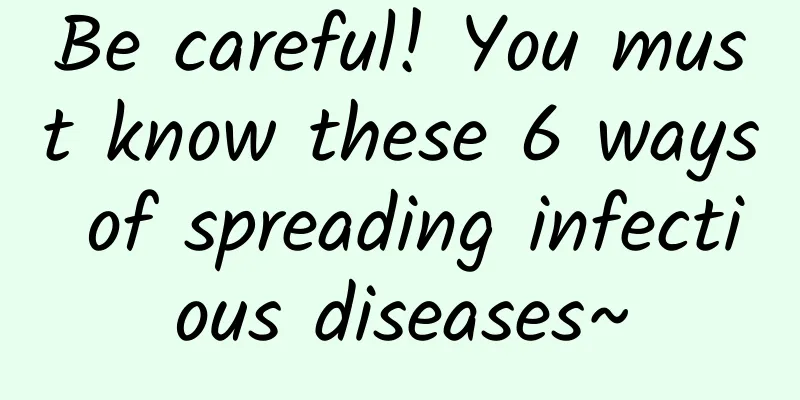Be careful! You must know these 6 ways of spreading infectious diseases~

|
Review of this article: Zhang Jieli, Deputy Chief Nurse, Fifth Medical Center, PLA General Hospital Zhang Xin, Deputy Chief Physician, Fifth Medical Center, PLA General Hospital Why is separate dining a healthy eating habit? Why should we be careful about mosquito breeding in our living environment? Why can we use hugs to convey encouragement to AIDS patients? Because gastrointestinal transmission and insect-borne transmission are the routes of transmission of infectious diseases; blood, body fluids and mother-to-child transmission are the routes of transmission of AIDS, while physical contact during hugging is not. Yes, these are actually related to scientific prevention of infectious diseases. Respiratory tract transmission, digestive tract transmission, contact transmission, insect-borne transmission, blood or body fluid transmission and mother-to-child transmission are the six ways of infectious disease transmission. 1. Respiratory transmission Copyright image, no permission to reprint After the pathogens are discharged from the body of the infectious source, they exist in droplets or aerosols in the air, causing infection when inhaled by the human body. For example: measles, tuberculosis, chickenpox, influenza, severe acute respiratory syndrome and new coronavirus pneumonia. 2. Digestive tract transmission Copyright image, no permission to reprint After the pathogens are excreted, they contaminate food, water or tableware, causing people to be infected through the mouth when eating or drinking. Infants and young children can be infected through contaminated milk or bottles or nipples. For example: bacterial dysentery, typhoid, cholera, rotavirus infection, etc. 3. Contact transmission Copyright image, no permission to reprint After pathogens are discharged from the body of the source of infection, they contaminate the soil, objects, etc., and people are infected when they come into direct or indirect contact with the contaminants. For example: leptospirosis, schistosomiasis and hookworm disease, etc. Some diseases may also cause infection when close contact is made in daily life, such as influenza, diphtheria, etc. Unclean sexual contact can spread AIDS, hepatitis B, hepatitis C, syphilis, gonorrhea, etc. 4. Insect-borne transmission Copyright image, no permission to reprint Mainly blood-sucking arthropods (such as mosquitoes, lice, rat fleas, sand flies, hard ticks, chiggers, etc.) transmit pathogens to others when they bite. For example: malaria, Lyme disease, epidemic typhus, etc. 5. Transmission through blood and body fluids Copyright image, no permission to reprint Pathogens can be transmitted to others through blood transfusion, use of blood products, organ transplantation, etc. For example: AIDS, hepatitis B, hepatitis C, etc. 6. Mother-to-child transmission Copyright image, no permission to reprint For some infectious diseases, the pathogens can infect the fetus through the placenta or through the birth canal during natural delivery. For example: AIDS, hepatitis B, etc. Another part can cause ascending transmission, that is, pathogens reach the chorion or placenta from the vagina of pregnant women and cause intrauterine infection of the fetus, such as herpes simplex virus, cytomegalovirus, etc. The spread and prevalence of infectious diseases are affected by natural and social factors. The survival and reproduction of all pathogens can be influenced and controlled by natural factors such as geography, meteorology, and ecological conditions. Some viruses are not resistant to high temperatures. In addition, the defense ability of the human respiratory mucosa decreases in winter and spring. Therefore, respiratory infectious diseases such as measles and chickenpox are more common in winter and spring. Schistosomiasis must rely on snails to survive, and snails can only live in water areas with mild climate, sufficient rainfall and overgrown weeds. Therefore, in my country, schistosomiasis is mostly prevalent in areas south of the Yangtze River. Japanese encephalitis is only transmitted by mosquitoes, and mosquitoes require specific temperature and humidity to reproduce. Therefore, in my country, Japanese encephalitis basically occurs in summer and autumn. Social factors that affect infectious diseases include social system, economic conditions, living conditions, cultural level, and hygiene concepts. After the founding of New China, the superiority of the socialist system has continued to emerge, people's living standards have continued to improve, and the country has implemented planned immunization, which has significantly reduced the incidence of many infectious diseases or nearly eliminated them. However, as the national economy continues to grow, the incidence of certain infectious diseases, such as AIDS, is gradually increasing due to factors such as population mobility, environmental pollution, and behavioral changes; or some new infectious diseases, such as SARS and new coronavirus pneumonia, are emerging. These should attract our attention. Author: Chen Dianjie, Fifth Medical Center, PLA General Hospital Source: Chinese Medical Association's "Popularizing Chinese Medical Health" project The watermarked images and cover images in this article are from the copyright gallery, and the image content is not authorized for reprinting |
>>: The king of summer! Do you know some interesting facts about watermelon?
Recommend
What does a high-conversion information flow ad look like?
For information flow advertising , the content an...
A brief analysis of the 7 types of super traffic content
What kind of content can attract users' atten...
FB executives interpret financial report: Asian user growth hits new high
Facebook today released its unaudited financial r...
Remember the "Ozone Hole"? It healed quietly!
When we were young, we often saw news reports abo...
Are male genes disappearing? New research reveals the genetic mystery of human Y chromosomes...
The Y chromosome is the true root of a man becaus...
Asteroids, micrometeors, fireballs...how do we distinguish between similar "stars"?
According to the solar nebula theory, the solar s...
"Asia's tallest tree" is in my country! A 102.3-meter-tall cypress tree was discovered in Tibet. How can it grow so tall?
How tall is the tallest tree in Asia? On the 26th...
From 0 to 3,000 followers, 6 points you must get
At the beginning, my public account only had doze...
Make iPhone fingerprint unlocking more sensitive | Qinggong
I believe everyone is familiar with "fingerp...
Meizu 16s Pro review: We see Huang Zhang's sincerity in creating an artistic flagship phone
Only four months after the release of Meizu's...
Suddenly, WeChat and Alipay can no longer deposit money
Recently, Alipay has taken down bank deposit prod...
Foreign home appliances are collectively falling, and it is time for domestic high-end home appliances to rise
In the past, in the minds of Chinese consumers, b...
Detailed explanation of gamification operation methods!
There are many problems in the user operation gro...
2020 wage tax deduction standards, wage personal income tax calculation formula
Our country's laws stipulate that if a worker...





![2020 Zero-cost Money-Making Strategy, Even a Newbie Can Make 200+ a Day [Video Tutorial]](/upload/images/67cc3794aaf4d.webp)



